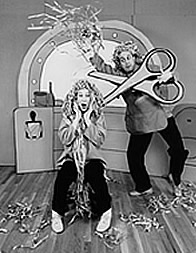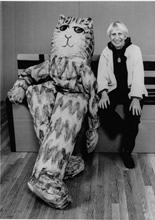
Paper Wins Again
By Patricia Sternberg
"Scissors, Rock or Paper" was
a game that most of us played as children. Scissors cut paper,
rock broke scissors, and paper covered rock. Paper is
clearly the winner once again with the Paper Bag Players. So often
theater for young audiences simply imitates adult theater with
realistic sets and costumes: scissor-like props, real rocks.
Director Judith Martin has created a children's world, immediately
accessible and intriguing, yet full of surprises, through the
unique use of brown paper, cardboard boxes, and even paper bags
turned into curly wigs. These are all familiar objects to both
adults and children (remember making a house from a refrigerator
box?). With a touch of imagination, a fantasy world is created
that children understand and are familiar with. Along with designing
this world, "The Bags" create their sketches, songs,
and other materials to deal with meaningful issues in the child's
world.
A major source of the Paper Bag Players’s critical success
is their original format and presentational style, which they
have stuck to since their beginning, forty years ago. This format
consists of several short pieces created by the actors and director,
which combine funny stories (often with a surprise ending), original
music, dancing, and audience involvement. The stories present
familiar situations in a child's life enlarged as fantasy, using
familiar environments with a fanciful look and often realistic
characters on a gigantic scale. These characters are sometimes
so large that a foot fills the whole stage, leaving the rest of
the character to the imagination. The group's humor often builds
on such discrepancies in size. Although the Bags’s style
is presentational, they also include an additional element of
personal involvement with the audience, as if to say, "We
are in your world, and we're playing together." They invite
the audience to enter the world with them, creating a kind of
conspiracy between them and the child audience, often with "call-and-response"
techniques.
The actors begin their shows wearing colorful coveralls. To these
they add various carefully selected details as they change characters:
an extra long scarf, a large red bow tie, a hand-painted jacket.
Behind this selection is a sensitivity to the particular look
and feeling of "dress up" that makes children feel they’re
in a world carefully constructed for them.
The Bags performance of The Cat's Meow, the latest play
in their repertoire, embraces their original concept of using
bags, boxes, cardboard cartons and ordinary household objects
for costumes and sets. One of the funniest scenes is the mother
taking her daughter for a hair cut. The hair is a brown paper
bag cut and curled. Of course, the child hates how her hair looks
afterwards--which brings back memories for many mothers in the
audience, including this one. The solution to the problem is timely,
however: the hairdo is transformed into green, “punker”
spikes, which could hardly be more fashionable.
The four actors performing in the current production are Kevin
Richard Woodall, Victoria Lauture, Ted Brackett, and Olivia Goode,
with Stephen Francis Vasta punctuating the action as musical director
and keyboard player. Each is exceptionally talented and extraordinarily
resourceful in employing the company’s presentational style,
particularly the men, who have been with the company for many
years. Woodall is like a young Danny Kaye with his graceful movements,
fanciful characters, and skillful mime creations. Brackett is
like a latter-day Buster Keaton. They would have made a great
vaudeville team. Their “Magic Box” sketch is a beautiful
example of their ensemble playing with the others: three actors
move as one while the fourth moves a box from one side of the
stage to the other, and the actors appear in and disappear from
it as if by magic.
Many of the call-and-response sketches are adapted year after
year for incorporation into new productions because the Bags’s
loyal audience expects them and looks forward to taking part.
For example, the family scene with the mother, father, and children,
dressed in fanciful tube-like cardboard costumes with bouncing
paper hair, always elicits strong participation. The audience
can't wait to get the family all together in one place, urging
each of the actors to go this way or that, to bring them all together.
A few in the audience always delight in giving the wrong directions.
Similarly, the "I don't want to take a bath scene" is
a perennial favorite. Children learn the song quickly, many remembering
it from the previous years, which gives them an opportunity to
identify actively with the child character as well as to vent
their own feelings.
The Paper Bag Players hold a unique position in the history of
children's theater. It is the only true repertory company--thirty-five
shows have been created and eleven are in the current repertory--and
it has been around since 1958 (no mean feat in itself). The number
of children’s theater companies that have come and gone
in the last forty years is in the hundreds. Nellie McCaslin, in
her book Historical Guide to Children's Theatre in America,
rightly says: "The Paper Bags have been fortunate in getting
sufficient funding to enable them to create new works and accept
no more engagements than they can handle without jeopardizing
their artistic standards. The result has been a consistently high
quality of work and a distinctive performing style."
In the book Theatre for Young People: A Sense of Occasion,
Helane S. Rosenberg and Christine Prendergast write that "the
key to theatre for young people, especially in today's world,
is that it should be presentational in style...When we talk about
style, we mean the behavioral characteristics shared by the play's
characters. Style is the precondition of the whole play; it colors
every aspect of production--how the characters walk, what they
say, what they value, what they wear, and how they move...No attempt
is made to fool the audience into thinking this place does exist.
A presentational play invites the audience to enter another world,
which may be a suggestion or symbol of life.” The Bags have
taken this point to heart.
Another distinction of their work is their ability to pitch performances
appropriately to a number of different age groups without making
any feel excluded. In the book Children, Theatre and Youth,
Jed H. Davis and Mary Jane Evans give audience profiles for different
ages. They say that four- and five-year-olds take the most pleasure
in "songs, dancing, making sounds; rhythmic participation;
physical involvement (participation); things and people that move;
unusual physical skills (acrobatics.)" In contrast, six-,
seven- and eight-year-olds find the most pleasure in "physical
movement as a clap-along (in rhythm to stage music); supplying
noises, sound cues, singing and other forms." The Paper Bag
Players fulfill the criteria for both groups and consequently
play to a larger public than most of their competitors.
The avant-garde director Charles Marowitz once saw a Paper Bags
performance in London and wrote about it in The Village Voice:
"Although it may be considered too high-falutin' to invoke
the name of Antonin Artaud in this context, the fact remains that
the strength of the Paper Bag Players' work is its mythic content.
In true Artaudian fashion, it employs objects, props and totems
which, realistic in themselves, become transformed through usage
into tangible and poetic equipment." Artaud wrote of the
need of the theater to steep itself in a poetry realized by a
return to primitive myths, using "the overlapping of images
and movement through the collusion of objects, silence, shouts
and rhythms, a genuine physical language with signs, not words
as its root." In truth, Marowitz was not exaggerating, but
stating the precise, practical truth about this company.
The driving force behind "The Bags" is Judith Martin,
Founder and Artistic Director. Martin's background as a visual
artist and a dancer is evident in all the performances. In a recent
interview, she summed up her feelings about what children's theater
should be:
 My
aim in making theatre for children is to create on the stage a
world that is immediately both accessible and intriguing, a place
where reality and fantasy mix in a way that children understand,
and where children themselves feel understood. This world is familiar,
yet full of surprises. It is also engaging and amusing. Uppermost
in my mind is to deal with material that deeply touches them.
For children, like adults, can find meaningful theatre a liberating
and exuberant experience.
My
aim in making theatre for children is to create on the stage a
world that is immediately both accessible and intriguing, a place
where reality and fantasy mix in a way that children understand,
and where children themselves feel understood. This world is familiar,
yet full of surprises. It is also engaging and amusing. Uppermost
in my mind is to deal with material that deeply touches them.
For children, like adults, can find meaningful theatre a liberating
and exuberant experience.
This statement touches on the crux of the company’s longevity:
their ability to reach the child at his/her own level of consciousness
through a diversity of format and an original presentational style.
Martin downplays the originality of the Bags’s concept,
calling their beginnings "a lucky accident." "It
just all came together," she said. "We loved the idea
of using found objects as part of our performance, not to mention
that it was an inexpensive way of creating a set. Games, stories
and dance illuminated a way of moving from one part of the work
to another. We all had a wonderful time. It was like making a
patchwork quilt.” They were especially interested in creating
surprises on stage, like transforming a box into a fish, or a
carton into a bathtub. They also had an ethic of relying on only
what they found on the streets, which reflected the nature of
their early opportunities.
"Once we had our show, we went into the streets to perform,”
Martin recalls. “We wanted to be friendly and accessible,
but we needed a home base. Julian Beck was directing the Living
Theatre at that time and invited the group to do the show at his
theatre on Saturdays. There was a very graphic drug abuse play,
The Connection, going on during the week.” From
then on--the rest is history.
Today the company gives approximately 150 performances each year
for over 80,000 children. Over five million children have seen
the Paper Bag Players perform to date. Their awards include an
OBIE for "raising the level of children's theatre through
intelligence and imagination," the Sara Spencer Award, and
the Jennie Heiden Award, the last two from the American Alliance
for Theatre & Education.
For all their success, the Paper Bag Players have problems too,
partly because, like all enterprises of a certain age, they must
function in a cultural environment less idealistic than when it
began. "It doesn't get easier," says Martin. "It's
always a struggle. I get nervous with every show. It's always
a challenge to make it work. Funding keeps drying up, and it's
a constant search to find people who are committed, who want to
work in children's theatre. Commercialism has overtaken the theatre.
It's wrong, but it's a fact. The sense of adventure is lost. I
think it's harder today than it was when we first began. The 60s
were full of people who wanted to do things, who loved theatre,
who felt the pure joy of doing. It didn't seem far-fetched not
to be making big money as long as you worked at what you loved.
Times were easier then."
Nevertheless, Martin is a woman who turns obstacles into opportunities.
She continues to direct the Paper Bag Players with an enthusiastic
drive and deep emotional commitment. Clive Barnes was right when
he called her "a national treasure."
[Patricia Sternberg is a professor in the Theatre Department
at Hunter College where she heads the Developmental Drama Program
and directs the Hunter College Mad Hatters, a group of college
students who perform for young audiences.]
